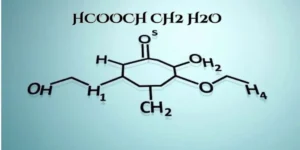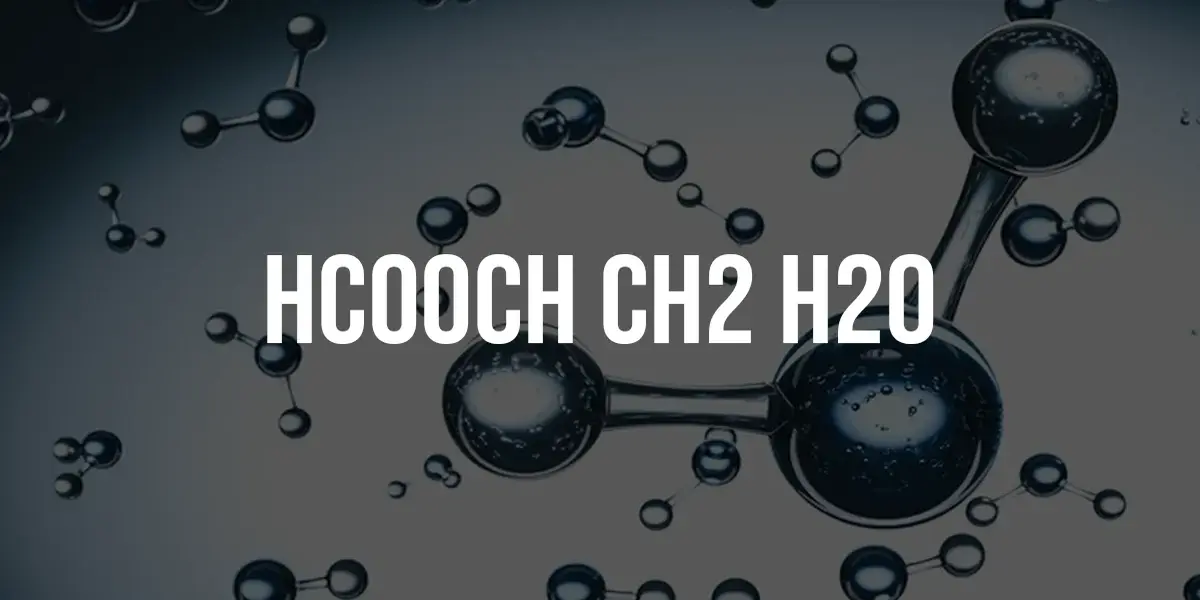Introduction
In the vast world of organic chemistry, the interactions between esters, alcohols, and water open doors to a variety of important reactions with significant industrial and academic implications. Hcooch Ch2 H2o one such interaction involves methyl formate (HCOOCH₃), methanol (CH₃OH), and water (H₂O). This combination represents a crucial equilibrium reaction primarily categorized under hydrolysis and esterification mechanisms, which are core topics in organic synthesis and biochemical processes. The importance of understanding this particular reaction extends from classroom concepts to the manufacturing of chemicals such as formic acid and methanol derivatives.
In this article, we will explore the chemistry behind these compounds, explain the reactions they undergo, and analyze their applications. Starting from the molecular structure of each component to their behavior under various conditions, this discussion aims to provide a comprehensive guide for students, educators, and professionals. By examining this reaction from both theoretical and practical viewpoints, we can better appreciate its versatility and relevance in scientific and industrial contexts.
Chemical Structure and Properties of HCOOCH₃, CH₃OH, and H₂O
Methyl formate, with the molecular formula HCOOCH₃, is a simple ester formed by the condensation of formic acid (HCOOH) and methanol (CH₃OH). It is a colorless, flammable liquid with a pleasant, ether-like odor. The ester functional group gives it reactivity characteristics typical of carbonyl-containing compounds, making it susceptible to nucleophilic attack during hydrolysis reactions.
Methanol, a simple alcohol with the formula CH₃OH, is one of the most basic organic solvents. Known for its use in laboratories and as a biofuel, methanol contains a hydroxyl (-OH) group, which makes it polar and reactive in esterification and hydrolysis reactions.
Water (H₂O), often considered the universal solvent, plays a dual role in this system. It acts both as a reactant and as a medium, facilitating the hydrolysis of esters like methyl formate and the reverse reaction of esterification, depending on the conditions.
Understanding the Reaction Mechanism
The interaction between HCOOCH₃, CH₃OH, and H₂O can be examined through two main reaction pathways: ester hydrolysis and esterification.
- Hydrolysis of Methyl Formate
Under acidic or basic conditions, methyl formate reacts with water to yield methanol and formic acid: HCOOCH3+H2O→HCOOH+CH3OH\text{HCOOCH}_3 + \text{H}_2O \rightarrow \text{HCOOH} + \text{CH}_3OHHCOOCH3+H2O→HCOOH+CH3OH
In acidic media, the carbonyl carbon of the ester becomes more electrophilic due to protonation. Water, acting as a nucleophile, attacks the carbon, leading to the cleavage of the ester bond and formation of formic acid and methanol. In basic hydrolysis, commonly referred to as saponification, a hydroxide ion initiates the reaction instead of water, and the products may differ slightly in their ionic form.
- Esterification Reaction (Reverse Reaction)
If methanol and formic acid are mixed in the presence of a strong acid catalyst like sulfuric acid, they react to reform methyl formate and water: HCOOH+CH3OH↔HCOOCH3+H2O\text{HCOOH} + \text{CH}_3OH \leftrightarrow \text{HCOOCH}_3 + \text{H}_2OHCOOH+CH3OH↔HCOOCH3+H2O

Thermodynamic and Kinetic Considerations
The reaction between methyl formate, methanol, and water is reversible and sensitive to temperature, pH, and the presence of catalysts. At room temperature, the reaction proceeds slowly unless a catalyst is introduced. Acidic catalysts such as HCl or H₂SO₄ are commonly used to increase the reaction rate by stabilizing transition states.
Thermodynamically, the hydrolysis of esters like methyl formate is slightly exothermic. The presence of excess water favors hydrolysis, while the removal of water shifts the reaction toward ester formation. Kinetics studies show that acid-catalyzed hydrolysis proceeds faster than uncatalyzed reactions, making it more efficient for industrial applications.
Industrial Applications and Importance
Methyl formate is extensively used in the production of formic acid, which is a valuable preservative and antibacterial agent in livestock feed. It is also used in leather processing and textile industries. The hydrolysis of methyl formate is an efficient method for formic acid production, especially where controlled breakdown of esters is required.
Methanol, another product and reactant in this reaction, is essential in the production of biodiesel, antifreeze, and formaldehyde. The ability to manipulate this reaction is vital in industries involving organic synthesis, pharmaceuticals, and agrochemicals.
Additionally, methyl formate is used as a blowing agent for polyurethane foams and as an intermediate in manufacturing formamide and dimethylformamide important solvents in organic synthesis.
Biochemical and Environmental Relevance
Beyond industrial use, the esterification and hydrolysis reactions involving compounds like HCOOCH₃ serve as model systems in biochemistry for understanding enzyme activity, particularly esterases and lipases. These enzymes catalyze similar reactions in living organisms, playing roles in digestion, detoxification, and cellular signaling.
Environmentally, methanol and formic acid are considered relatively biodegradable and less toxic than many synthetic organic chemicals. However, careful handling is still necessary due to methanol’s toxicity upon ingestion or inhalation. Methyl formate, while less harmful, can release methanol upon hydrolysis, necessitating proper storage and disposal measures.
More Read: Brainpath Junction
Experimental Setup and Lab Synthesis
To observe this reaction in a laboratory setting, one can mix methyl formate and water under reflux with an acid catalyst to drive hydrolysis. The progress of the reaction can be monitored using titration, gas chromatography, or infrared spectroscopy. Conversely, esterification can be demonstrated by reacting formic acid and methanol under similar conditions with a dehydrating agent or by removing the water formed during the reaction to drive equilibrium toward ester production.
The yields can vary based on concentrations, temperature, and time. Refluxing ensures constant temperature and prevents loss of volatile reactants such as methanol and methyl formate, which boil at relatively low temperatures.
Safety and Handling Considerations
All three substances methyl formate, methanol, and water require specific safety precautions. Methanol is highly toxic and can cause blindness or death if ingested. Methyl formate is flammable and may cause respiratory irritation. Adequate ventilation, the use of gloves, and eye protection are necessary during handling. Spill kits, fire extinguishers, and fume hoods should be readily available in lab and industrial settings.
Proper labeling and storage of chemicals are also essential. Methanol and methyl formate should be kept in tightly sealed containers away from heat sources, while water should be distilled or deionized in high-purity reactions.
Conclusion
Hcooch Ch2 H2o the reaction involving methyl formate (HCOOCH₃), methanol (CH₃OH), and water (H₂O) is a prime example of ester chemistry in action. Whether undergoing hydrolysis to produce formic acid and methanol or undergoing esterification in the presence of catalysts, this system illustrates the delicate balance and reversibility of organic reactions. Its significance is not limited to theoretical chemistry it spans industrial applications, biochemical relevance, and environmental impact. Understanding the underlying mechanisms, conditions that influence the direction of the reaction, and safety protocols makes it a versatile and essential topic for students and professionals alike.
Moreover, this knowledge forms the backbone of several industrial processes that contribute to manufacturing, agriculture, and even medicine. As science advances, so does our ability to control and optimize such reactions for specific outcomes. This interplay between organic compounds continues to be a central theme in chemistry and innovation, proving that even the simplest molecules can produce complex and useful results when combined with precision.
FAQs:
What is HCOOCH₃ commonly known as?
HCOOCH₃ is known as methyl formate, a simple ester derived from formic acid and methanol.
Is the reaction between Hcooch Ch2 H2o reversible?
Yes, the reaction is reversible. Methyl formate and water can form methanol and formic acid, and vice versa.
What is required to speed up the hydrolysis of methyl formate?
Acid or base catalysts are used to speed up hydrolysis. Reflux conditions and an excess of water can also help drive the reaction.
Why is methanol dangerous?
Methanol is toxic and can cause serious health issues, including blindness and death if ingested or inhaled in large quantities.
What is the industrial use of this reaction?
This reaction is used in the production of formic acid, methanol derivatives, solvents, and intermediates in chemical synthesis.
Visit for more, Truswiki











